
Please wait, I'm coming over...

Last Changed 5/8/2011 |
||
|
RVers need to carry an assortment of electrical adapters to accommodate the various RV park power pole offerings. Many RVs
today are wired for 50 amp service (two 50 amp @ 120 volt for a possible 100 amps). Most RV parks offer 50 amp service either as
standard or as an extra cost option. Smaller or older RVs may have only a 30 amp service (one 30 amp @ 120 volts). Most RV
park power poles that offer 50 amp service also have a 30 amp outlet. Older RV parks may only have the 30 amp outlet available. If you are not well versed in household wiring, look at Electrical Basics for some fundamental information. |
||
50 amp Service |
||
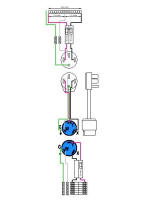 |
We start at the power pole where a double pole 50 amp circuit breaker is inline with the two Hots and the outlet. A dual pole circuit breaker is used to break both circuits if either circuit senses an over-current condition. These wires attach to the two outer flat blade contacts. The Neutral is attached to the center flat blade contact. Finally, the Ground is attached to the round center contact. If you look at the 50 amp power cord plug that goes into the outlet, you should see that the round prong is longer than the blades on the plug so that the Ground contact is made before the others. This is for safety. It is very important for the plug to be firmly seated with the 50amp outlet. If the plug should be cocked, it is highly possible that the Neutral contact could be lost and the 120 volt circuits in your RV could become 220 volts. | |
click on image to enlarge |
||
|
For the record, the three flat blade plus round prong outlet is considered a 120/240 50 amp household outlet. Most RVs now have a detachable power cord. The plug/receptacle at the RV end is a twist lock type plug. Twist the plug to lock it after inserting it into the receptacle. This is a reverse receptacle/plug combination in that the male blades are in the receptacle and the female contacts are in the plug. If you look at the end of the plug, you will only see three contacts. Two have curved “L” shaped holes which are the Hots. The other hole is for the Neutral. The Ground does not have a hole. The Ground is attached to a plate on the outside edge of the plug. Like the longer Ground prong on the power pole end of the cord, the Ground plate is designed to make contact before any of the blades do for safety reasons. Because of the twist lock, this plug rarely can be cocked. From the RV inlet receptacle, the wiring goes to the RV Circuit Breaker Panel. If you have a generator, the power will travel through a transfer switch before it gets to the Panel. There is a double pole breaker at the input to the Circuit Breaker Panel to again open both circuits if either senses an over-current condition. From there, each Hot goes to a separate bus. To these two buses, 110 volt breakers of appropriate amp ratings are attached for the separate circuits in the RV. We generally refer to these buses as legs. Either of the two buses could have a problem. The voltage could be higher on one leg than the other. This is important if you are checking voltage by inserting a Good Governor into an outlet. You need to know where outlets from each leg are so that you check both legs. |
||
30 amp Service |
||
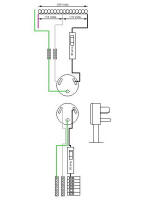 |
We start at the power pole where a single pole 30 amp circuit breaker is inline with the one of the two Hots and the outlet. The wire attaches to the one of the flat blade contacts. The Neutral is attached to the other flat blade contact. Finally, the Ground is attached to the round center contact. If you look at the 30 amp power cord plug that goes into the outlet, you should see that the round prong is longer than the blades on the plug so that the Ground contact is made before the others. This is for safety. | |
click on image to enlarge |
||
Just for the record, the two flat blade plus round prong outlet is considered a TT-30R amp travel trailer outlet. This different from the type of outlet used by appliances where the Ground prong is “L” shaped instead of round. Like in the 50 amp Service description, most RVs now have a detachable power cord. The plug/receptacle at the RV end is a twist lock type plug. Twist the plug to lock it after inserting it into the receptacle. This is a reverse receptacle/plug combination in that the male blades are in the receptacle and the female contacts are in the plug. If you look at the end of the plug, you will only see three contacts. One has a “L” shaped hole which is for the Ground. The other two holes are for the Hot and the Neutral. From the RV inlet receptacle, the wiring goes to the RV Circuit Breaker Panel. If you have a generator, the power will travel through a transfer switch before it gets to the Panel. There is a single pole breaker at the input to the Circuit Breaker Panel. From there, the hot goes to a bus. To this bus, 120 volt breakers of appropriate amp ratings are attached for the separate circuits in the RV. This is generally referred to as a single leg. |
||
30-50 amp Dog Bone Adapter |
||
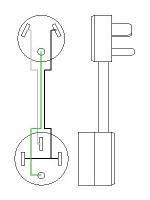 |
We generally refer to some of these adapters as dog bones because the plug and receptacle at each end of a short piece of cable looks
a little like a dog bone. Also instead of the long 50 amp Male to 30 amp Female description, we use a shorten format of the male
amps first followed by the females amps. In a 30-50amp adapter, the plug has two flat blades and the round prong. The Hot wire is used to attached to both Hot wires in the Adapter receptacle end along with the Neutral and the Ground. This Adapter allows 50 amp style connections to a 30 amp power pole receptacle. Caution should be used because the 50 amp style connection could expect 100 amps of power (50 amps on each leg) and the outlet can only deliver 30 amps for both legs. The power pole breaker will protect the outlet. The is probably the most used Adapter when 50 amp RVs visit older RV parks that have only 30 amp service. |
|
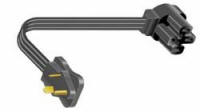 |
||
click on image to enlarge |
||
50-30 amp Dog Bone Adapter |
||
 |
We generally refer to some of these adapters as dog bones because the plug and receptacle at each end of a short piece of cable looks
a little like a dog bone. Also instead of the long 50 amp Male to 30 amp Female description, we use a shorten format of the male amps
first followed by the females amps. In a 50-30amp adapter, the plug has three flat blades and the round prong are present to insure good fit into the receptacle. Only one of the Hot wires is used to attach to the Hot wire in the Adapter receptacle end along with the Neutral and the Ground. This Adapter allows 30 amp connections to a 50 amp power pole receptacle. Caution should be used as a 30 amp cord is not designed to carry 50 amps. In a electrical short situation, 50 amps will be pulled down the cable before the 50 amp breaker on the power pole trips. However, if the 30 amp connection is a RV, the RV Panel breakers should trip before a dangerous load is placed on the power cord. |
|
 |
||
click on image to enlarge |
||
30-30 amp Generator Adapter |
||
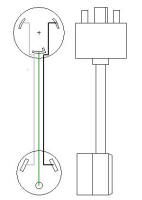 |
Optional: This is a specialized adapter that fits 30 amp generator outlets and adapts a standard 30 amp RV plug end cable. We acquired this adapter when we stayed at a marina. Boats use the same type of plugs as generators use. |
|
 |
||
click on image to enlarge |
||
30-15 amp Adapter |
||
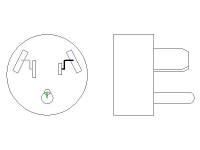 |
This Adapter is wired within the format of a 30 amp plug. The Hot, Neutral and
Ground from the male plug are attached to the same in the female receptacle. The caution is that you are attaching 15 amp cords and devices to a receptacle that can deliver 30 amps before the breaker will trip. |
|
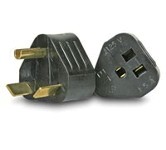 |
||
click on image to enlarge |
||
15-30 amp Adapterr |
||
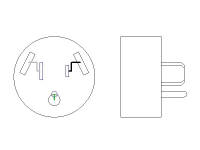 |
This Adapter is wired within the format of a 30 amp plug. The Hot, Neutral and
Ground from the male plug are attached to the same in the female receptacle. This Adapter is often used to temporarily power a 30 amp RV to a regular outlet. You have to remember that only 15 amps is available. |
|
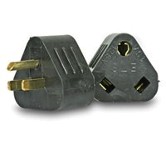 |
||
click on image to enlarge |
||
50-15 amp Adapted System |
||
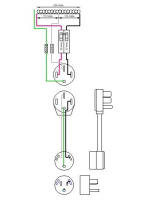 |
If we put a 50-30 amp Adapter into a 50 amp power pole receptacle, then put a 30-15 amp Adapter into the first Adapter receptacle, we
can connect a 15 amp extension cord to a 50 amp receptacle. The caution of using lower amp rated cords should be observed. We used this combination to use our Good Governor with its 15 amp plug to monitor the 50 map power pole receptacle before we plugged in. This combination allowed us to test only the leg that was attached in the 50-30 amp Adapter. |
|
click on image to enlarge |
||
15-50 amp Adapted System. |
||
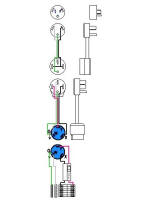 |
We start with a 15-30 Adapter and plug into it a 30-50 amp Adapter. Now we can attach a 50 amp style connection to a 15 amp
receptacle. We use this combination when we need to hook up our 50 amp RV to a 15 amp receptacle to temporarily run some light appliances in the trailer. |
|
click on image to enlarge |
||
(2) 30-50 amp Adapter |
||
 |
This is a special adapter that connects two 30 amp outlets to a 50 amp outlet. By using adapters, 15 amp outlets can also be used.
If two 30 amp outlets are used, you could get up to 60 total amps into you 50 amp service RV. This is not the normal 100 amps
capability but better than only 30 amps. A word of caution, if two 30 amp outlets are used, the two outlets should be on separate legs. If they should be on the same leg, there could be 60 amps on the RV line cord Neutral. This would not be a problem if one of the outlets is only 20 amps or less. |
|
click on image to enlarge |
||
A Creative Solution |
||
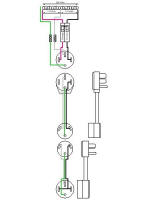 |
We used this solution to temporarily solve a problem. We did this in mind that we were stressing the electrical wiring in the
adapters a bit and because of that, we limited the time of the stress. We had a problem with a poor neutral in an RV Park. By limiting our usage to only one leg of the park power we eliminated a high voltage issue (this is a complicated issue, just consider the outcome). At first we used a 30-50 amp adapter into the 30 amp outlet as that uses only one power leg. The hair dryer or the toaster would flip the 30 amp breaker. |
|
click on image to enlarge |
||
|
By using a 50-30 amp adapter into the 50 amp outlet and the 30-50 adapter into the 50-30 adapter we gave ourselves some more current capacity. The 50-30 adapter used only one park power Hot leg which again eliminated the high voltage problem. The 30-50 adapter connected the two trailer Hot legs to the one park Hot leg. This gave us 50 amps of current, enough to get by the hair dryer and toaster moments. This was not a long term solution as we were limited by the single 50 amp leg. Also, the wiring in the adapters is only of 30 amp rating and not good for long term 50 amp draws. |
||
Disclaimer: The information in this site is a collection of data we derived from the vendors and from our personal experiences. This information is meant as a learning guide for you to make your own decisions Best practices and code should always be followed. The recommendations we make are from our personal experiences and we do not receive any compensation for those recommendations. |